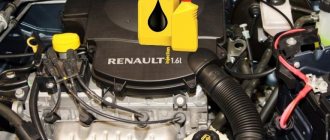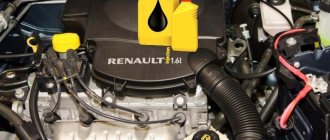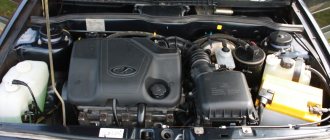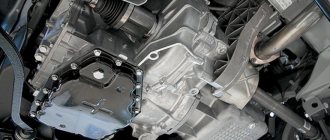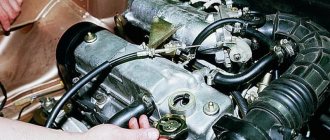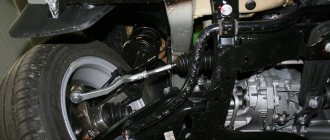1200 rub. for the photo report
We pay for photo reports on car repairs. Earnings from 10,000 rubles/month.
Write:
Changing the oil in the Lada Largus engine is a common procedure for periodic vehicle maintenance, which is performed approximately every 15 thousand km. mileage (some drivers change it to 10). Any man can change the engine oil with his own hands—there’s nothing complicated about it.
Changing the oil in a Lada Largus (16 valves) involves removing the crankcase protection. Otherwise, you won’t be able to get to the oil filter, which also needs to be replaced. After removing the protection, you need to place a container for used oil, unscrew the drain plug, and drain the oil.
While he's running away, you can work on the oil filter. To remove it, you will need a puller . There are several types of oil filter pullers, but in this case the so-called “crab” is most suitable.
This video with instructions will allow you to see how to change the oil and oil filter on a Lada Largus.
The choice of oil for internal combustion engines should be given special attention, since the operation of your vehicle depends on its quality. Therefore, you need not only to replace it on time, but also to know what consumables to fill. Now you can find out which engine oil is suitable for Lada Largus and how to change it.
We change the oil ourselves
There is nothing scary about this process - even a person who has never driven a car can handle it. If you follow the steps and tips described in this material, you will be able to do everything correctly and your “iron horse” will be very grateful to you.
Which oil is suitable?
The choice of motor oil (hereinafter referred to as MM) for replacement in the 16 valve Lada Largus engine is the first difficulty faced by a car owner who decides to replace this consumable. We need to dwell on this point in more detail, since many Lada owners often make mistakes when choosing motor fluid.
Car Lada Largus
As mentioned above, the quality of this consumable material affects the operation of the engine, as well as the wear resistance of the elements of the internal combustion engine system. If the filled engine oil is of low quality or does not meet the vehicle manufacturer’s recommendations, then the service life of the machine is significantly reduced. In addition, if your car is relatively new and is under warranty, then if you operate a low-quality MM, you may simply be denied engine repair if necessary.
To find out exactly what consumables should be filled into the Lada Largus, you should read the service manual for your car. The necessary parameters and characteristics that the motor fluid must have are clearly indicated there.
In particular, for a 16-valve Largus engine, the manufacturer recommends using a MM that meets the following quality classes:
Preparation for replacement and necessary tools
Novice drivers sometimes have no idea which oil filter for the Lada Largus is best for them to buy. To do this, you can refer to the factory’s recommendations and inspect the model of the product that was installed off the assembly line. It is advisable to purchase this component made by one of the world's famous manufacturers. Buying a fake is almost equivalent to a clogged filter.
Most products of this operating principle are a glass with a metal body. Inside there are two valves for inlet and outlet and the filtration element itself, made of special paper. Before replacing it, you should carry out preparatory work and stock up on equipment. It is necessary to consider the location, since the car will have to be raised above the ground. Before starting work, warm up the engine for several minutes so that the old lubricant becomes more liquid and flows out more easily.
Now you need to prepare the following:
- consumable components (new lubricant and filter assembly);
- set with wrenches (socket, socket, wrench);
- removable filter key;
- set of rags;
- watering can;
- empty container for “working off”.
The role of the container is usually played by any empty plastic canister. If a puller is not available, then use any available tool such as a screwdriver or chain.
How to drain engine oil
You will need : buy engine oil and an oil filter, prepare a “10” wrench, an “8” square wrench, a clean cloth, an empty 5 liter container. and a wire brush.
The engine oil should be drained after a trip while the engine is still warm (if necessary, warm it up to operating temperature). It is recommended to drive the car onto an overpass.
Procedure:
- Unscrew the oil filler plug.
- (At the bottom of the car on the engine crankcase), clean the drain plug with a wire brush, then unscrew it. Be careful not to burn yourself!
- After all the oil has run out (about 10 minutes) into a previously placed container, clean the plug from dirt and screw it back.
Under the plug there is a steel washer on the surface of which a thin layer of rubber is vulcanized. If it is damaged, replace the washer with a new one. If you do not have a new washer, you can install a copper washer with a hole diameter of 18 mm under the plug.
Signs of a clogged oil filter
The main purpose of the oil filter is to clean the circulating oil from impurities. They arise during the production of lubricating fluid, friction of mechanisms, and temperature changes.
A pressing issue for many car owners is identifying signs of the need for replacement . These usually include:
- extraneous sounds in engine operation, twitching, vibration;
- reduction in engine power, activation of the emergency light;
- change in lubricant color, appearance of sediment, burnt odor.
However, experts do not recommend waiting for such factors to manifest themselves. These signs already indicate malfunctions in the system and increased wear of parts. To prevent costly repairs, attention is paid to preventive measures and timely replacement of the lubricant and oil filter.
Read more: Checking fines by car number with photo
Regarding the operation of the filter itself, its throughput is emphasized. When worn, it decreases, which limits the supply of lubricant to the operating mechanisms of the engine.
Many car owners, instead of completely replacing the oil filter, clean it and return it to its place. This option is allowed as a temporary measure, however, for a long-term effect, the filter element must be changed along with the oil.
How to fill engine oil
We pour new oil into the engine through the oil filler neck, the amount of oil in the engine is indicated in the table above. (about 0.3 liters of oil will still remain in the engine). We control the level using the oil dipstick (the oil level should be between the MIN and MAX marks).
Start the engine and let it idle for a few minutes. The emergency oil pressure indicator should go out 2-3 seconds after starting the engine. While the engine is running, check for oil leaks from under the drain plug and oil filter. Stop the engine and check the oil level; if necessary, add oil to the specified level.
The entire process of changing the Lada Largus oil is also shown in the video:
Changing the oil and oil filter on Lada Largus
Any car owner is faced with the fact that his vehicle someday needs an engine oil change. For Lada Largus, AvtoVAZ recommends doing this after 15 thousand kilometers if the car is new. Subsequent replacements should be made every 10 thousand kilometers. So, let's hope that you have chosen an oil that fully complies with the manufacturer's recommendations and are ready to start replacing.
To change the engine oil filter on a Lada Largus you will need the following:
• Special key on 4 sides (size 8 mm); • Wrench size 19mm; • Oil filter remover; • O-rings for the filler cap; • Bucket or container for draining used oil; • Rags or rags; • Actually, the canister itself with new oil and the filter for it.
Oil change work must be performed on an overpass or in a garage where there is a pit. Please note that it is better to replace it after the engine has warmed up - in this case, the viscosity of the oil will be higher and it will be able to leak out of the engine completely.
Remove the engine protection, which is bolted to the bottom of the car. Once you are under the car, use rags to clean the area around the drain plug from dirt, oil and other deposits. A bucket or container into which the used oil will be drained should be prepared in advance.
Start unscrewing the drain plug at the bottom of the machine. To do this you will need a square wrench. When you feel that the plug is about to unscrew completely, press the plug up so that the oil does not start to drip from under it.
Place a bucket under the drain plug to allow the oil to drain out later. If the engine has recently been run, be careful not to allow hot oil to come into contact with your skin. Also note that there may be a steel ring on the drain. Examine it. If the rubber layer around this ring is worn out, then this ring must be replaced.
Then open the hood and look for the oil filter, it is located at the bottom.
Attach the oil filter wrench to the filter itself. Tighten the central nut of the device clockwise (either with a wrench or by hand).
Continue to tighten it even after you feel that the puller's legs have tightly grasped the filter - the filter will begin to unscrew. Please note that you should twist counterclockwise.
Remove the oil filter with a puller.
Pull the filter out of the puller key, then very carefully, trying not to spill, pour a little oil into it.
The filter rim should also be lubricated with oil.
If possible, clean the filter seat near the cylinder block from oil smudges and dirt. After this, install the filter in its place and begin to tighten it clockwise until the sealing rubber touches the cylinder block. Screw the filter until it stops.
Wait for the oil to completely flow out from the bottom of the car (the volume takes about 5 liters, the oil completely flows out in about half an hour). If necessary, install a new ring on the drain plug-cover.
Next, use a clean rag or rag to wipe the oily area around the drain hole, removing all stains. After this, start screwing the drain cap back on by hand.
Thanks for subscribing!
Tighten the drain cap with a square until it stops.
Unscrew the engine filler cap.
Carefully, trying not to spill, begin pouring new oil from the canister. The total volume required by the engine is 4.8 liters.
After the oil has been added, screw on the filler cap.
Then get into the car and turn on the ignition (do not start the engine). Make sure that the low engine oil pressure indicator on the instrument panel goes out. Then get out of the car and inspect the installed filter. There should be no traces of oil around it (if you cleaned the area around it before installation). Also check the area around the drain hole at the bottom of the machine - it should also not contain any leaks. After this, start the car and leave it idling. A few minutes will be enough for the oil to start draining into the oil pan. Then turn off the engine, get out of the car and check the oil level with a dipstick. If necessary, add it.
